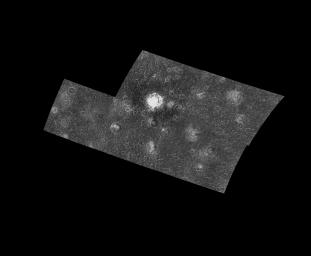
|
Moderate-resolution view of Callisto’s surface
- Click the image above for a larger view
- Full-Res JPEG (2170 x 1788) (218.5 kB)
- Full-Res TIFF (2170 x 1788) (866.9 kB)
Caption:
This five-frame mosaic of the Jovian satellite Callisto shows a surface densely populated with impact craters. However, close inspection of this image reveals differences among the craters. For example, a few of the craters contain central dome-shaped features, while others contain depressions, or pits, within the crater floor. Scientists study differences among craters such as these to learn more about both the surface that was struck by an impactor, and the impactor itself.
These images were obtained by the Galileo spacecraft on its eighth orbit around Jupiter at a distance of 48,000 km from Callisto. The mosaic is centered at 31 S. latitude and 122 W. longitude, and covers an area approximately 700 kilometers (420 miles) by 900 kilometers (540 miles)-- somewhat larger than Montana. The finest details that can be discerned in this picture are about 1.8 kilometers across (0.93 km/pixel).
Background Info:
The Jet Propulsion Laboratory, Pasadena, CA manages the mission for NASA's Office of Space Science, Washington, DC.
This image and other images and data received from Galileo are posted on the World Wide Web, on the Galileo mission home page at URL http://galileo.jpl.nasa.gov. Background information and educational context for the images can be found at http://www.jpl.nasa.gov/galileo/sepo .
Cataloging Keywords:
| Name | Value | Additional Values |
|---|---|---|
| Target | Callisto | Jupiter |
| System | Jupiter | |
| Target Type | Satellite | Planet |
| Mission | Galileo | |
| Instrument Host | Galileo Orbiter | |
| Host Type | Orbiter | |
| Instrument | Solid-State Imaging (SSI) | |
| Detector | ||
| Extra Keywords | Crater, Grayscale, Impact | |
| Acquisition Date | ||
| Release Date | 1998-03-26 | |
| Date in Caption | ||
| Image Credit | NASA/JPL/ASU | |
| Source | photojournal.jpl.nasa.gov/catalog/PIA00898 | |
| Identifier | PIA00898 | |
